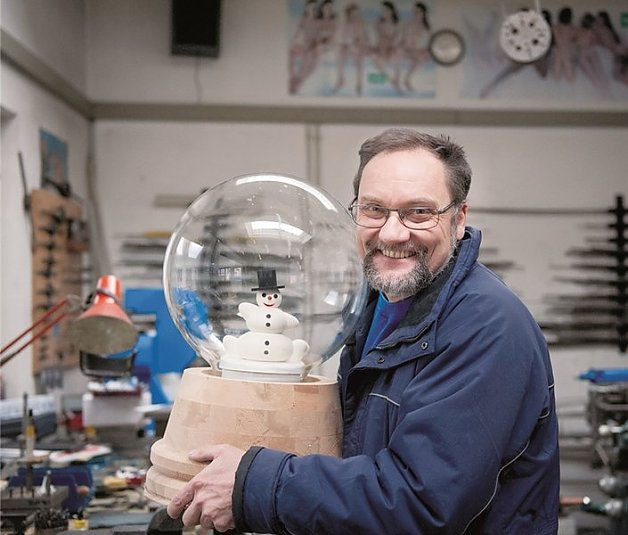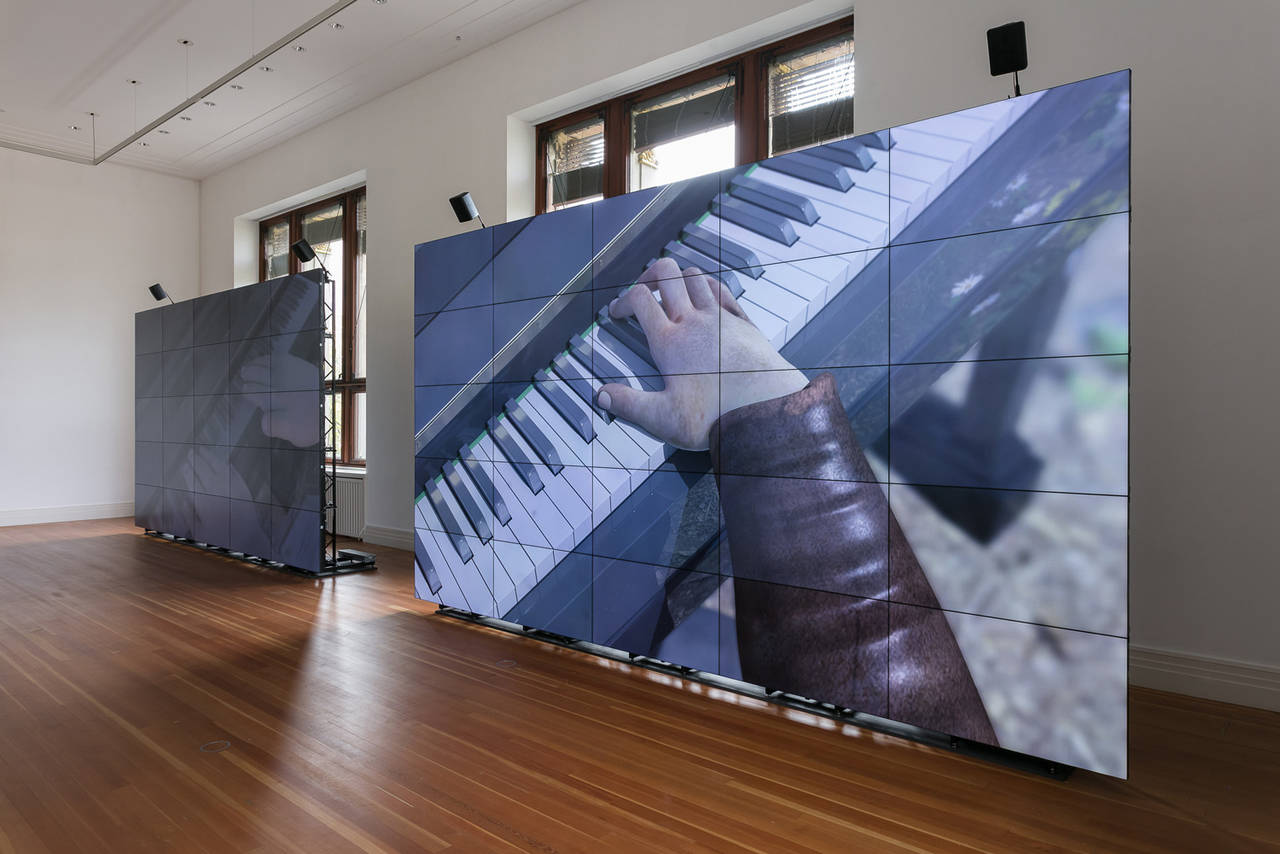How the world’s first snow globe came about and why even adults are unable to resist them: A phone call with Erwin Perzy III, grandson of Erwin Perzy, who founded the Vienna snow globe factory.
Mr. Perzy, Christmas is coming. What’s it like right now in the snow globe factory?
Here it’s snowing like crazy at this very moment! Things are running full steam ahead. In fact, we’re even working at the weekends now. Lots of custom-made items are only ordered very late – it all comes at once and at very short notice.
Who exactly is “we”?
We have a total of 15 employees on site and another 40 who work from home, painting the figures, for example. They all live in Vienna and the surrounding area. From the first design to the finished product, we make everything ourselves. Only the glass spheres, wooden bases and packaging are bought in from well-known businesses in Austria and the Bavarian forest.
Tell us the story of how your grandfather first invented the snow globe.
My grandfather was a craftsman – a surgical instrument technician, to be precise. And he wanted to improve on Edison’s light bulb. And that’s how the snow globe came about! [laughs] In fact he was on the hunt for a sterile light for operating rooms. That was in 1900, back when operating rooms were still lit by gas: It gave very bright, white light, but it also produced fumes, so it wasn’t sterile. My grandfather recognized that Edison had actually invented the perfect lamp for the operating room. The only problem was that the reddish light emitted was very dark in comparison. His friend was a shoemaker, and it was from him that he discovered the so-called “shoemaker’s globe”: This was a glass ball filled with water, which was mounted on top of a candle and worked like a lens, strengthening the candlelight. At any rate, something that would fit in the palm of your hand gave light that appeared much brighter than the candle itself. He therefore decided to try it with a bulb instead of a candle. It worked – although it was impossible to illuminate an entire operating room with something the size of a hand. This led him to try out other things too: First he tried with glass chippings added to the water to get greater distribution, but they immediately sank to the bottom. On the hunt for a lighter material that floated in the water, he came across semolina, which he found in his mother’s kitchen. This gradually began to float…

Embedded via Instagram @snowmanthethird
I see how that could work … but how do you get from floating semolina to the idea of developing a snow globe of which you had absolutely no preconception?
The floating semolina was the basic idea; the chain of coincidence doesn’t end there. My grandfather also had a tin smelter, and he had a friend in Mariazell, a place of pilgrimage here in Austria. His friend sold the usual souvenirs, rosaries and candles and so on, but wanted to stand out from the competition. So he asked my grandfather: Erwin, might you be able to cast a model of Mariazell Church instead of the usual tin soldiers? And he did just that. And for some reason he also put this church into the glass sphere, turned it upside down, and it snowed onto the church. I don’t think he’d even thought about it before. It was entirely a chance invention, a combination of these two discoveries.
Indeed, even though we might find more Christmas trees and snowmen than churches in our snow globes today, your basic product has barely changed in more than a century. There are no music or light effects, no bells and whistles. What is it about the snow globe, this remarkably simple miniature world, that still fascinates us today?
The product as such has not changed, only the production process. My grandfather still produced everything from metal, but now we use plastic. And he only made churches, everything to do with religion – Christ figures, crosses for the pilgrimages sites. It was my father who came up with the idea of making a Christmas item out of it, and to fill it with the familiar figures. The snowman remains the favorite to this day, and he even features in our company logo. And it’s successful in all cultural circles: We sell to Saudi Arabia just as we do to America, Europe and Australia.
One reason why we manufacture our snow globes in the same way we used to is a practical one: We don’t want to buy in any electronic gadgets – the quality is often inconsistent and we wouldn’t then be able to sell our snow globes as an Austrian product. The second reason, however, is that the item is brought to life by the snow and by what features in it. The snow globe is actually a toy for adults – and that’s all you need really. I see it time and again at exhibitions: When my customers pick up a snow globe and something happens that stops them from wanting to put it down again. A snow globe is like an idyllic little world.

Embedded via Instagram @snowmanthethird
And to make sure it snows perfectly, you presumably don’t use semolina any more.
Now that we’ll soon have real snow again, I’ll start collecting it for the months to come. [laughs] Not really! The snow recipe is my secret, I won’t reveal it to anyone. My father only revealed it to me after I had passed my master craftsman exam, and the same will apply to my daughter, who will represent the fourth generation.
Alongside the traditional motifs, you also produce custom-made items, as you mentioned. Do you ever get really extravagant inquiries?
There’s one story I really like: A lady came to me with two wedding rings. She wanted to have them incorporated into a globe to then throw at her husband – the pair were divorcing. I was able to convince her to do something else: I added two female friends and the Statue of Liberty in the globe, with a red base to match the color of love and a shield on it reading: “Yesterday’s snow”. They both liked it, the wife and the husband, and they really laughed. They still divorced though.
You’re also willing to supply more famous customers with custom-made items …
Yes, three American presidents have snow globes made by us: Ronald Reagan, Clinton and Obama.

Embedded via Instagram @snowmanthethird
Has Donald Trump not expressed an interest yet?
Well, not yet … let’s just say he’s not necessarily a popular president, but of course I’d be willing to make a snow globe for him.
When the Christmas period is over do you then get a bit of a break, or is it always snow-globe season?
Traditionally the period between January and March is quieter of course, the time when I can often be found on an airplane, traveling to trade shows in New York, Tokyo. But before that my wife and I will be travelling to Hong Kong, where a Christmas market is being opened, and some of the rarities from our museum are being presented there.
Erwin Perzy III is the third generation of the Perzy family to manage the Viennese snow globe factory. Today it sells products all over the world – and the company’s own museum is open outside of the Christmas season too. There are reports of similar snow globes in circulation around the turn of the century, so it may be that the idea was pursued by different people in parallel. Regardless, the Perzys are the only ones who can trace their invention all the way through to the present day.

Erwin Perzy III., Image embedded via austria-forum.org

How Virtual Reality conquers the art world
Ever danced with a wolf? Artist duo Djurberg & Berg make it possible with their first virtual reality work. They are part of a young generation of...

The enemy of my enemy
From August 23 onwards, a unique project by artist Neïl Beloufa will transform the SCHIRN into a stage. Palais de Tokyo is currently hosting Beloufa's...

In the vicious circle of sadness
As part of the “Immersion” series, British artist Ed Atkins is presenting an exhibition at Martin-Gropius-Bau that addresses our ubiquitous escapism...

The border between reality and fiction
Its productions turn the theatergoer into an actor: An interview with performance collective SIGNA about immersion, fiction and its play “Das halbe...

From window to pool
The distance between viewers and film is becoming ever smaller. Even 120 years ago, cinemagoers were jumping out of their seats as a locomotive...

A walk-in diorama
These days, computer games are discussed in arts supplements. What is their appeal and how do they develop such a strong draw for people? Let’s play!

Hats off, it’s Wagner
The opera “Mondparsifal Beta 9-23” by Jonathan Meese at Berliner Festspiele draws visitors into a cosmos where logic plays only a subordinate role.

Complete dissolution
Is complete immersion in a virtual world a utopia or a dystopia? These and other questions are answered by Prof. Rupert-Kruse, immersion researcher,...

Noise interference from a distant world
An experience for all the senses: An exhibition at Kunstverein Frankfurt invites viewers to immerse themselves in virtual and constructed worlds

Who lives here?
Visitors can immerse themselves in a long bygone era at the Dennis Severs House in London. A truly great experience.

A journey back in time to a divided Berlin
It might not look very exciting from the outside: A large black rotunda that has landed on the onetime “Death Strip” of the Berlin Wall like a...

Diorama. Inventing Illusion
Reality or illusion: The SCHIRN presents a major exhibition dedicated to the idea of staged vision.

Zombies like us
The Internet is full of the undead. The artist duo New Scenario makes them visible — in works that function online, and even offline sometimes.

The dream of watching in 360°
Humans have always had a burning desire to watch, to observe. Now, virtual reality is opening up entirely new possibilities for the creation of...

Exhibited realities
In the exhibition “Diorama. Inventing Illusion” artists question staged visions and reconstructed realities. In modern everyday culture, this...